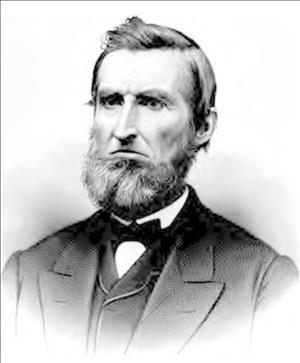Seattle pioneer Edward Hanford, logger, orchardist, farmer, and a founder of South Seattle, was the brother-in-law of one of the first white men to visit the future King County, John C. Holgate (1828-1868). In 1852, Holgate had written to his sister, Abigail (Holgate) Hanford, describing the beauties and bounties of the region. The Hanfords sold their Iowa farm in 1852 and traveled westward along the Oregon Trail. The party included Edward and his brothers George and Ebenezer, Edward's wife Abigail, and three children. (Two more children were born in Seattle.) The Hanfords settled in South Seattle in 1853. They logged the land, planted orchards and gardens, and were founding members of Seattle's First Baptist Church. Several Hanford children became notable citizens of the region.
From Forest to Orchard
With hard work and the help of his brothers George and Ebenezer, Hanford logged the area. They used a single-bit ax, and the job was tiring and slow. After land was cleared, they started gardens and planted acreage in fruit orchards. The first Hanford home was a traditional log cabin built in 1853 just above the shore at the north line of today's Hanford Street, just south of Pioneer Square.
Hanford's logs went to Henry Yesler's steam-powered sawmill in downtown Seattle. Ox teams from his Iowa herd that had hauled the Hanford family from Portland and across the plains were used to remove logs from the surrounding woodlands. Logs were pulled to a chute on the hill, then sent down to the tidelands. At high tide, they were floated to Yesler's mill.
The Battle of Seattle
Just before the Indian uprisings and the 1856 Battle of Seattle, Hanford traded one of his ox teams for a river scow. When warned by an Indian named Duwamish Curley that an attack was imminent, the clumsy scow saved the lives of the Hanford family and the next-door Holgate family. Everything possible was piled aboard the scow, which was briefly stranded on the mudflat at low tide. After freeing the craft late at night during high tide, the two families proceeded on to the home of friends on Commercial Street (now 1st Avenue) between Main and Jackson streets.
Because of overcrowding, the Hanfords moved to David Livingston's cottage on the triangular block that was later the site of the Seattle Hotel, now the "sinking garage" monstrosity. While the Hanfords and Holgates were at the Livingstons, Indians attacked Seattle on January 26, 1856. The Battle of Seattle lasted one terrifying day and night.
While tending his orchards and gardens in south Seattle, Edward Hanford thought it wise to temporarily locate his family near the town. The Hanfords occupied a house on the northwest corner of 2nd Avenue and Cherry Street, the present (2002) location of the stately Hogue Building.
Brothers-in-law John Holgate and Edward Hanford took their logs from Beacon Hill. Shortly after they settled the area, that hill was called Holgate and Hanford Hill. Streets were named after each of them. Hanford Street ranges from Lake Washington on the east to Puget Sound on the west.
Seattle was a proper settlement by the mid-1860s, with churches, schools, and a county government. In 1869, several people met at Edward and Abigail Hanford's home to establish Seattle's First Baptist Church. In 1872, after meeting in the Hanford home, the congregation built a church at 4th Avenue and James Street.
In 1870, Edward Hanford filed the plat of his donation claim in south Seattle. Roberta Frye Watt, writer and granddaughter of Arthur Denny, noted that Hanford's plat reflected names from the recently ended Civil War: "Lander, McClellan, Stevens, Sheridan, Grant, Sherman, Sterrett, and Gansevoort."
The Seattle Hanfords
Edward and Abigail Hanford had five children who survived to adulthood: Thaddeus (1847-1892), Cornelius (1849-1926), Frank (1853-1921), Arthur (1855-1932), and Clarence (1857-1920). Arthur and Clarence were born in Seattle. Cornelius Holgate Hanford became a prominent territorial and then federal judge as well as a writer. His three volume Seattle and Environs, 1852-1924 added wonderful detail to the Seattle story. The eldest son Thaddeus graduated from the University of Rochester and later became a newspaperman in Seattle. At one time he owned the Daily Intelligencer.
Edward Hanford, Seattle pioneer, logger, orchardist, family man, and founder of South Seattle, died in the city he loved on September 24, 1884.

